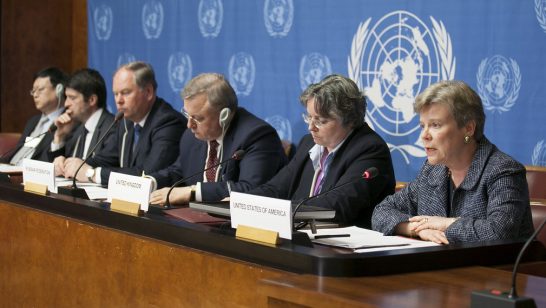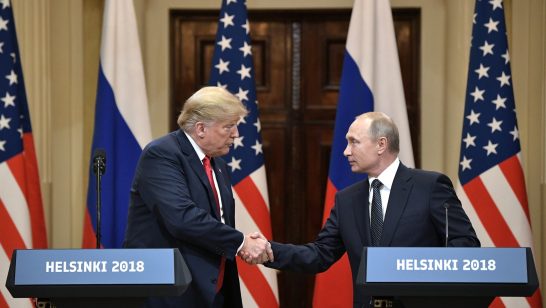
Last year Russian Valdai Club experts published a report about the current world order. They compared it to a shabby house, one which cannot be reconstructed nor pulled down but requires constant repair so not to collapse too quickly. The same analogy can be applied to the state of bilateral arms control.
With this perspective, the INF Treaty was doomed to failure. A landmark Cold War agreement, it eliminated for the first time an entire class of nuclear weapons with strict verification mechanisms. However, over the past 10 years or more, under the pretext of mutual accusations of violation, both parties were driving the other to get rid of this legacy treaty.
Russia did not want to be the first to lay the INF to rest. Moscow is fond of international law and historically has always seen itself as one of the few guarantors of strategic stability. Believe it or not, Russia’s official policy is based on preserving as many treaties as possible. The philosophy is simple: a stoic belief in the strength of legally-binding commitments, even in a crumbling world.
The last decades have seen the United States adopt a completely different approach. The sole superpower has no desire to stay bound to agreements that place constraints on its political and military superiority. This attitude has further consolidated due to President Trump’s mindset and ongoing power race with a rising China.
The pretext for the INF’s demise
In this respect, the INF has fallen victim to the merging of three factions in the US. The first, the Pacific-oriented lobby, wants leverage against China and its increasingly sophisticated nuclear arsenal. They argue that they need INF-prohibited medium-range missiles back. The second group is comprised of those willing to punish Russia for anything, real or bogus, as part of the political witch-hunt in the US. The third group consists of fervent opponents of any treaties and additional restrictions on US military development, like National Security Advisor John Bolton. This is not to mention the military-industrial complex which received orders for the research and development of new weapon INF banned systems long before the US officially withdrew from the treaty.
In the end, there was no escaping the mindless pretext of mutual allegations of non-compliance. Washington complained about the Russian SSC-8 cruise missile, despite the Russian attempts to demonstrate most of the missile’s technical characteristics. Moscow in response argued that it faced a threat from NATO’s missile defences, specifically the MK41 vertical launch system and its target missiles. Neither party provided clear evidence of its allegations. In the world of post-truth all that was needed was the allegations to do the job. Nowadays, you either trust or distrust a party and its position, irrespective of rational conviction. The optics, political climate and the volume are far more important.
As a consequence, after the US decision to withdraw from the treaty Russia received political dividends from the domestic public and non-Western world. It was portrayed as a peace dove out to save global agreements. Though in reality neither the US or Russia wants to save the INF. Moscow’s position is clear – we have taken so many steps forward, there is no more room for flexibility and concessions. Russia is not going to further deteriorate the situation and will likely act reactively, in its usual manner. If the United States refrains from stationing medium-range missiles in Europe, Moscow won’t take any proactive measures in this area either. However, if we get back to a situation akin to the early 1980s with NATO deploying Pershing missiles and adopting a dual-track decision, the response will be harsh. The strategic risks for Moscow are higher this time. Poland and the Baltic states are much closer to the Russian capital than Germany. Meanwhile, in response to the US military developments, Russia will continue working on the ground-based version of the SS-N-27 “Sizzler”, on hypersonic missiles and on the Poseidon nuclear-powered unmanned underwater vehicle – all openly declared in President Putin’s address to the Federal Assembly in February 2019.
The not-so-rosy picture for the future of arms control
The future of arms control is in danger. Most of the treaties that formed the core of the arms control system are either gone, or are being undermined. So there is likely more to come with respect to the dismantling decades-long agreements. What’s worse is that Russia and the United States no longer want to lead by example by carrying the bilateral burden of disarmament, while other nuclear armed states are reluctant to join them on this peaceful path. In this way, the original sin of the nonproliferation and arms control regime – the exclusiveness of the recognized nuclear club – starts to play a more and more crucial role in global affairs.
Furthermore, generational change and rapid technological progress indulge those who believe that a nuclear war can be won. People are less fearful of the probability of a nuclear war, the history of nuclear tragedies is a distant memory (though thanks to the “Chernobyl” HBO series it has returned slightly to the general consciousness) and political tensions between Moscow and Washington or Washington and Beijing are growing. All this helps the warmongers to sound assertive.[1]
This creates a mood of pessimism about the extension of START III. The Trump administration plans to delay the negotiations until early 2020. This will shorten the time for negotiations, making them fiercer and placing them in the midst of the US presidential campaign, reducing the chances for further disarmament.
Meanwhile, the rest of the world attempts to stimulate peace, through for example the creation of the Nuclear Ban Treaty. However, there is little response on the part of real nuclear stakeholders who demonstrate no desire to get rid of their arsenals and do their best to advance them. Unlike during the Cold War, the antinuclear movements are marginal in politics. Hence, it may seem from the nuclear-weapon capitals that the international community is indifferent. The current dominating sentiments in the Western world indicate clear unwillingness to negotiate with President Putin about anything serious and strategic, thereby essentially postponing any action until 2024 or 2025.
What can the international community, and Europe in particular, do?
The common goal of Europe, the United States and Russia could be to restrict China, India and Pakistan, or at least to involve them in a multilateral process of disarmament. The recent Russian-Chinese joint statement on strengthening global strategic stability in the modern era signed on June 5, 2019 is a step in the right direction. Nonetheless, its wording does not imply any further practical steps and may be interpreted as anti-American, thus inhibiting the prospects, if any, for trilateral progress.
NATO’s usual cautious position in supporting the United States without really doing anything to help resolve the disagreement is also dangerous. It puts the final nail in the coffin of the INF at the time when a reasonable and assertive European position is needed to influence all parties and save arms control.
Obviously, treaties do not prevent countries from taking certain actions. However, they do set at least the minimum threshold of diplomatic politeness, strengthened by the fear of mutually assured destruction. At this point, the future of arms control looks gloomy. It would be in the interest of the international community, notably European countries, to exert more pressure on Washington and Moscow to save the existing agreements, to convince other nuclear-weapon states across the globe to make the disarmament process multilateral and to shape new commitments. Unfortunately, there is little enthusiasm, and we seem doomed to see the continuation of the crumbling world order for the foreseeable future.
[1] Pursuing enhanced strategic stability through Russia-U.S. dialogue. Recommendations by Russia-U.S. working group reported by Adlan Margoev, May 2019 (http://www.pircenter.org/media/content/files/14/15613679830.pdf).
The opinions articulated above also do not necessarily reflect the position of the European Leadership Network or any of its members. The ELN’s aim is to encourage debates that will help develop Europe’s capacity to address pressing foreign, defence, and security challenge.



